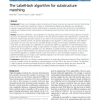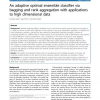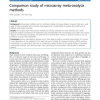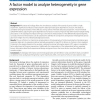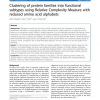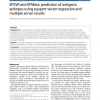BMCBI
2010
13 years 11 months ago
2010
Background: There is an increasing number of proteins with known structure but unknown function. Determining their function would have a significant impact on understanding diseas...
BMCBI
2010
13 years 11 months ago
2010
Background: Generally speaking, different classifiers tend to work well for certain types of data and conversely, it is usually not known a priori which algorithm will be optimal ...
BMCBI
2010
13 years 11 months ago
2010
Background: Direct in vivo investigation of human metabolism is complicated by the distinct metabolic functions of various sub-cellular organelles. Diverse micro-environments in d...
BMCBI
2010
13 years 11 months ago
2010
Background: Meta-analysis methods exist for combining multiple microarray datasets. However, there are a wide range of issues associated with microarray meta-analysis and a limite...
BMCBI
2010
13 years 11 months ago
2010
Background: Microarray technology allows the simultaneous analysis of thousands of genes within a single experiment. Significance analyses of transcriptomic data ignore the gene d...
BMCBI
2010
13 years 11 months ago
2010
Background: We propose a method for deriving enzymatic signatures from short read metagenomic data of unknown species. The short read data are converted to six pseudo-peptide cand...
BMCBI
2010
13 years 11 months ago
2010
Background: Recent biological discoveries have shown that clustering large datasets is essential for better understanding biology in many areas. Spectral clustering in particular ...
BMCBI
2010
13 years 11 months ago
2010
Background: Phylogenetic analysis can be used to divide a protein family into subfamilies in the absence of experimental information. Most phylogenetic analysis methods utilize mu...
BMCBI
2010
13 years 11 months ago
2010
Background: Many newly detected point mutations are located in protein-coding regions of the human genome. Knowledge of their effects on the protein's 3D structure provides i...
BMCBI
2010
13 years 11 months ago
2010
Background: Accurate prediction of antigenic epitopes is important for immunologic research and medical applications, but it is still an open problem in bioinformatics. The case f...
